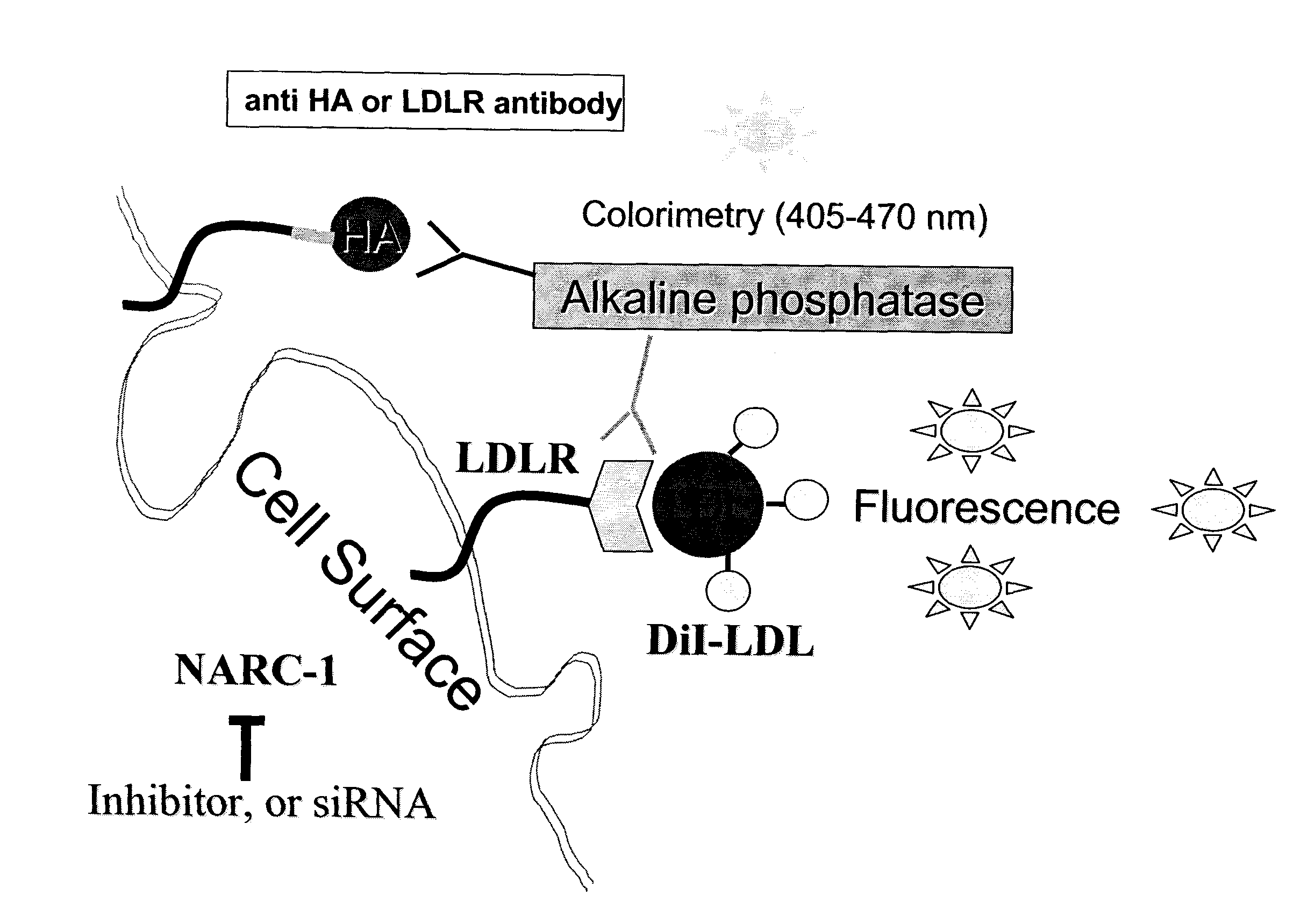Screening proteinase modulators using a chimeric protein and ski-i proprotein convertase substrates and inhibitors
- Summary
- Abstract
- Description
- Claims
- Application Information
AI Technical Summary
Benefits of technology
Problems solved by technology
Method used
Image
Examples
example 1
Cell-Based Inhibitors Screening for Constitutively Secreted Furin-Like PCs
Construction of Chimera
[0109]A chimeric type-I membrane bound cell-surface protein was devised that exhibited the best substrate consensus for Furin, PC5, PC7 and PACE4. Because the HeLa cell, which does not express PC5, was used as host, it could not be screened for PC5 inhibitors.
[0110]The constructions were obtained by standard PCR and cloning techniques (Wiley, J. & Sons) and was made in the model vector pcDNA3 (Invitrogen). The cDNA and amino acid sequences appear in FIG. 17-18. The chimera presented contained the short ACE2-CT form (FIG. 17) or the full length ACE2-CT form (FIG. 18).
[0111]One chimera (SEQ ID NO: 48) obtained consisted of 1) a N-terminal human Renin signal sequence (SP) (SEQ ID NO: 68); followed by 2) a 9 amino acid HA-Tag in bold (YPYDVPDYADTTTF) (SEQ ID NO: 74), where DTTTF (SEQ ID NO: 75) is a linker of HA to the bait sequence, 3) a bait sequence for proteinase cleavage (KRIRLRR-SPD (S...
example 2
Cell-Based Proteinase Inhibitor Screening SKI-1 Inhibitors
[0121]A CELISA specific to the SKI-1 was designed using the approach described in Example 1 above, with adaptations. One chimera expressing a bait specific for SKI-1 (IYISRRLL-GTFS (SEQ ID NO: 30)) and a short CT and one chimera with the same bait and the full length-ACE2 CT were constructed as described in Example 1 and used to transfect HuH7 cells.
[0122]The constructions were obtained by standard PCR and cloning techniques and was made in the model vector pcDNA3 (Invitrogen). The cDNA and amino acid sequences appear in FIGS. 19 and 20.
Selection of Pools of Cells
[0123]HuH7 cells were submitted to two rounds of fluorescence activated cell sorting (FACS) using Alexa488™ as fluorophore with a MoFlo™ cell sorter (Cytomation, Fort Collins, Colo., USA) to obtain pools of cells expressing the Fc (Fc positive) but negative for the HA tag (HA negative) (Data not shown). The presence of Fc tags was the sign that cleavage by SKI-1 PCs ...
example 3
Cell-Based Aspartic Protease BACE Inhibitors Screening
[0126]A CELISA specific to BACE was designed using the approach described in Example 1 above, with adaptations. Two chimeras mimicking the Swedish mutation in β-amyloid precursor protein βAPP (FIG. 5) were constructed as described in Example 1 using two sequences known to be cleavable by BACE (KISEVNL-DAE (SEQ ID NO: 33)) and (KISEVNF-EVE (SEQ ID NO: 34)) and the short ACE2-CT segment. Corresponding chimeras with the full length ACE2-CT segment are also constructed since the pH optimum of BACE is acidic and it cleaves bAPP in the TGN or endosomes.
[0127]The short CT chimera constructions were obtained by standard PCR and cloning techniques and were made in the model vector pcDNA3 (Invitrogen). The cDNA and amino acid sequences of the short CT chimera appear in FIGS. 24 (BACE) and 26 (BACE mutant). The cDNA and amino acid sequences of the full length CT chimera appear in FIGS. 25 (BACE) and 27 (BACE mutant).
[0128]These chimeras are...
PUM
| Property | Measurement | Unit |
|---|---|---|
| Length | aaaaa | aaaaa |
| Ratio | aaaaa | aaaaa |
| Hydrophobicity | aaaaa | aaaaa |
Abstract
Description
Claims
Application Information
 Login to View More
Login to View More - R&D
- Intellectual Property
- Life Sciences
- Materials
- Tech Scout
- Unparalleled Data Quality
- Higher Quality Content
- 60% Fewer Hallucinations
Browse by: Latest US Patents, China's latest patents, Technical Efficacy Thesaurus, Application Domain, Technology Topic, Popular Technical Reports.
© 2025 PatSnap. All rights reserved.Legal|Privacy policy|Modern Slavery Act Transparency Statement|Sitemap|About US| Contact US: help@patsnap.com



